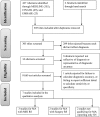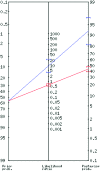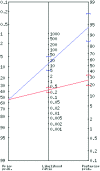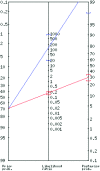ACCURACY OF THE LEVER SIGN TO DIAGNOSE ANTERIOR CRUCIATE LIGAMENT TEAR: A SYSTEMATIC REVIEW WITH META-ANALYSIS
- PMID: 30276010
- PMCID: PMC6159492
ACCURACY OF THE LEVER SIGN TO DIAGNOSE ANTERIOR CRUCIATE LIGAMENT TEAR: A SYSTEMATIC REVIEW WITH META-ANALYSIS
Abstract
Background: The Lever sign has gained recent notoriety for its purported anterior cruciate ligament (ACL) diagnostics and simplicity of performance.
Purpose: The purpose of this systematic review with meta-analysis is to summarize the diagnostic accuracy of the Lever sign for use during assessment of the knee for an ACL tear in subjects with suspected acute and chronic knee injury.
Study design: Systematic review with meta-analysis.
Methods: A computer-assisted literature search of MEDLINE, CINAHL, and EMBASE databases using keywords related to diagnostic accuracy of the knee joint. The Preferred Reporting Items for Systematic Reviews and Meta-Analyses (PRISMA) guidelines were used for the search and reporting phases of the study. Quality assessment of bias and applicability was conducted using the Quality of Diagnostic Accuracy Studies (QUADAS). Mixed effects models were used to summarize accuracy.
Results: Eight articles, with only two demonstrating high quality, were included. Six of the articles were included in a meta-analysis. Diagnostic values, utilizing arthroscopy as a gold standard, were: pooled SN 0.55 (95% CI 0.22 to 0.84), pooled SP 0.89 (95% CI 0.44 to 0.99), positive likelihood ratio (+LR) 9.2 (95% CI 0.70 to 46.1), negative likelihood ratio (-LR) 0.58 (95% CI 0.18 to 1.28). Post-test probability with a positive finding (57% sampling prevalence) reached 92% (95% CI 83 to 97%). Post-test probability with a negative finding (57% sampling prevalence) reached 43% (95% CI 39 to 47%).
Conclusions: Based on limited evidence of heterogeneous methodological quality, the Lever sign can moderately change post-test probability to rule in an ACL tear. These results should be interpreted cautiously due to a limited number of studies, with small sample sizes and study quality affecting test accuracy. Future investigation should be expanded to include additional high-quality studies examining diverse clinical contexts, as they become available, to enable a more comprehensive clinical examination of this test.
Level of evidence: 3aPROSPERO Registration # CRD42018084954.
Keywords: Lever Sign; anterior cruciate ligament; diagnostic accuracy; knee; sensitivity; specificity.
Figures




Similar articles
-
Diagnostic Accuracy of Physical Examination Tests for Suspected Acute Anterior Cruciate Ligament Injury: A Systematic Review and Meta-Analysis.Int J Sports Phys Ther. 2022 Aug 1;17(5):742-752. doi: 10.26603/001c.36434. eCollection 2022. Int J Sports Phys Ther. 2022. PMID: 35949377 Free PMC article.
-
DIAGNOSTIC ACCURACY OF THE LEVER SIGN IN DETECTING ANTERIOR CRUCIATE LIGAMENT TEARS: A SYSTEMATIC REVIEW AND META-ANALYSIS.Int J Sports Phys Ther. 2019 Feb;14(1):2-13. Int J Sports Phys Ther. 2019. PMID: 30746288 Free PMC article.
-
The diagnostic accuracy of clinical tests for anterior cruciate ligament tears are comparable but the Lachman test has been previously overestimated: a systematic review and meta-analysis.Knee Surg Sports Traumatol Arthrosc. 2022 Oct;30(10):3287-3303. doi: 10.1007/s00167-022-06898-4. Epub 2022 Feb 12. Knee Surg Sports Traumatol Arthrosc. 2022. PMID: 35150292 Free PMC article.
-
Diagnostic Accuracy of Imaging Modalities and Injection Techniques for the Diagnosis of Femoroacetabular Impingement/Labral Tear: A Systematic Review With Meta-analysis.Am J Sports Med. 2017 Sep;45(11):2665-2677. doi: 10.1177/0363546516686960. Epub 2017 Jan 27. Am J Sports Med. 2017. PMID: 28129509 Review.
-
Lever sign test shows high diagnostic accuracy for anterior cruciate ligament injuries: A systematic review and meta-analysis of 3299 observations.Knee. 2024 Mar;47:81-91. doi: 10.1016/j.knee.2024.01.003. Epub 2024 Feb 3. Knee. 2024. PMID: 38310817 Review.
Cited by
-
Evaluation of Diagnostic Tests.Methods Mol Biol. 2021;2249:319-333. doi: 10.1007/978-1-0716-1138-8_18. Methods Mol Biol. 2021. PMID: 33871852
-
Lever sign test for anterior cruciate ligament injuries: a diagnostic meta-analysis.J Orthop Surg Res. 2024 Mar 1;19(1):155. doi: 10.1186/s13018-024-04635-w. J Orthop Surg Res. 2024. PMID: 38429720 Free PMC article.
-
Is Lever Test Superior to Lachman, Pivot Shift, Drawer Tests in Diagnosing Anterior Cruciate Ligament Injuries?Cureus. 2022 Feb 9;14(2):e22049. doi: 10.7759/cureus.22049. eCollection 2022 Feb. Cureus. 2022. PMID: 35340524 Free PMC article.
-
The influence of anesthesia-body mass index and chronicity of the injury on the reliability of diagnostic tests for anterior cruciate ligament rupture.J Exerc Rehabil. 2021 Dec 27;17(6):428-434. doi: 10.12965/jer.2142580.290. eCollection 2021 Dec. J Exerc Rehabil. 2021. PMID: 35036392 Free PMC article.
-
Diagnostic Accuracy of Physical Examination Tests for Suspected Acute Anterior Cruciate Ligament Injury: A Systematic Review and Meta-Analysis.Int J Sports Phys Ther. 2022 Aug 1;17(5):742-752. doi: 10.26603/001c.36434. eCollection 2022. Int J Sports Phys Ther. 2022. PMID: 35949377 Free PMC article.
References
-
- Parwaiz H Teo AQ Servant C. Anterior cruciate ligament injury: A persistently difficult diagnosis. Knee. 2016;23(1):116-120. - PubMed
-
- Decary S Ouellet P Vendittoli PA Roy JS Desmeules F. Diagnostic validity of physical examination tests for common knee disorders: An overview of systematic reviews and meta-analysis. Phys Ther Sport. 2017;23:143-155. - PubMed
LinkOut - more resources
Full Text Sources
Research Materials
